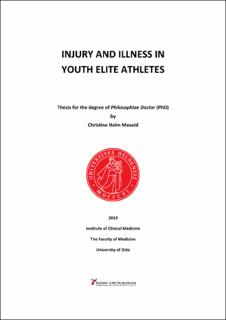| dc.description.abstract | Introduction: The health benefits associated with youth sports participation are well recognized. At the elite level, however, are these advantages in fact outweighed by an increased risk of injury and illness? There are strong opinions in the public debate regarding how best to achieve success in youth sport, but research is limited. Specialized sport academy high-schools enable youth athletes to combine high-school and sports at the elite level. There is no consensus, however, regarding when intensive, sport-specific training programs need to start, what the requirements are for youth elite athletes to improve skills vs. minimizing injury and illness risk, and how physical and mental overload can best be avoided. The purpose of this thesis was to increase the level of knowledge about the magnitude of health problems in youth elite athletes (Paper I) and to conduct studies analyzing potential risk factors for injury and illness expressed through (i) early single-sport specialization, (ii) performance level (Paper II), and (iii) level of physical fitness (Paper III).
Methods: This was a 26-week prospective cohort study. The study included youth elite athletes (n=260) newly enrolled into three selected specialized sport academy high-schools in Norway, representing a variety of endurance, technical, and team sports, as well as a convenience sample of their teammates (n=60) attending regular high-schools. At baseline, they completed a questionnaire covering anthropometrics, medical history, and sport history and performed physical fitness tests related to endurance, strength, agility, and speed. Both the athletes and their coaches were asked to evaluate performance levels at baseline. To assess weekly injuries and illnesses, we used the Oslo Sports Trauma Research Center Questionnaire on health problems.
Main results: At any given time, 43% (95% CI 37% to 49%) of the youth elite athletes reported a health problem, and 25% (95% CI 20% to 31%) reported a substantial health problem. Girls reported more health problems than did boys (53%, 95% CI 42% to 64% vs. 39%, 95% CI 32% to 46%). Most injuries were reported in team sports (37%, 95% CI 29% to 45%) and technical sports (36%, 95% CI 25% to 48%), whereas most illnesses were reported among the endurance athletes (23%, 95% CI 15% to 35%). Team sport athletes reported more substantial injuries vs. their teammates (22%, 95% CI 16% to 30% vs. 10%, 95% CI 5% to 20%) (Paper I). In Paper II, we demonstrated that youth elite athletes with a sport history of early and single-sport specialization were not at a greater risk of incurring injury and illness after enrollment into a specialized sport academy high- school environment, nor were the best-performing youth elite athletes. The athletes with performance level ratings within the top 10%, who reported more overuse injuries compared to the other athletes (1.0, 95% CI 0.9 to 1.2 vs. 0.8, 95% CI 0.6 to 1.0), were an exception. In Paper III, we demonstrated that the least fit youth elite athletes were not at a greater risk of injury or illness compared to the other athletes. The least fit girls, who reported more overuse injuries compared to the other girls (0.9, 95% CI 0.1 to 1.7 vs. 0.3, 95% CI 0.1 to 0.6), were an exception. There was also a trend wherein the least fit endurance athletes reported more illnesses than did the other endurance athletes.
Conclusions: Nearly half of the youth elite athletes attending specialized sport academy high-schools reported a health problem every week, and 25% weekly reported a substantial health problem. In our study, neither early specialization nor single-sport specialization appeared to represent risk factors for injury and illness among the youth elite athletes. Similarly, neither high performance level nor low physical-fitness level appeared to represent risk factors for injury and illness among the youth elite athletes. The great burden of health problems applied to these youths, however, is a concern, and further preventative work is warranted. | en_US |
| dc.description.abstract | Paper III: Moseid CH, Myklebust G, Slaastuen MK, Bar-Yaacov JB, Kristiansen AH, Fagerland MW, Bahr R. The association between physical fitness level and number and severity of injury and illness in youth elite athletes. Scand J Med Sci Sports. doi: 10.1111/sms.13498. Epub 2019 Jun 17. | en_US |
